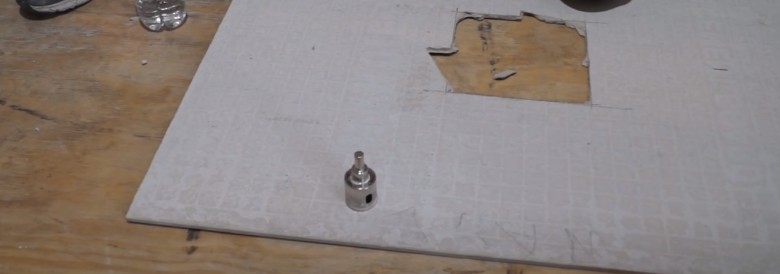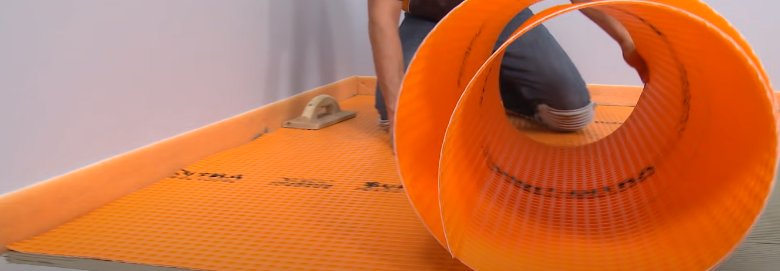When it comes to shower construction we always struggle with cement board or Ditra. Cement board and Ditra are popular underlayments for Tile, concrete, and wall constructions.
Thereby, Cement board floors work just like drywall and Ditra is the coupling membrane from Polyethylene working like a base.
Moreover, they protect your household structure, construction, and countertops. You’re here, which means that you don’t know much about these.
Worry not, I’ll differentiate and compare the Schluter Ditra vs. Cement board Floors. Thus, you can consider getting the best one.
A Quick Comparison Between Table
In case you want a glance at the comparison without going through all the details. Here is the table to know the price differences of the Cement board and Ditra.
| Specifications | Cement Board | Ditra |
| Material Type | Cement, fiberglass, fillers, cellulose, mica, limestone four, silica, and many other | Polyethylene uncoupling membranes and laminated fleece underside |
| Fundamentals | Cement board floor with cutting assembling tools | Waterproof membrane and Ditra installation kits |
| Quality | Good | Fantastic |
| Durability | Great sturdiness | Amazing sturdiness |
| Variations | A lot of material and design variation | Varieties of Styles and flexibility |
| Installation Method | Direct, easy procedure, and requires installation hardware | Time lengthy process requires installation kits |
| Resistance | Water and moisture | Water, heat, and moisture |
| Service | Long-lasting | Average |
| Availability | High | High |
| Pricing | Inexpensive | Expensive |
| Adhesiveness | Great | Well enough |
Differences Between Schluter Ditra And Cement Board Floor

As you know about what Cement boards and Ditra, you can get ahead. Now, it is the right moment for you to dive right in for in-depth information.
There are many factors and criteria you need to consider before deciding on a choice. So, learn how to differentiate and compare those factors to find out which one is better.
- Quality Resistance & Durability
The top-tier criteria you should consider comparing Schluter Ditra and Cement Board Floor is resistance and durability.
After going through the durability and quality we found out that the Schluter Ditra consists of a bit more quality sturdiness than Cement boards.
Ditra is more flexible and capable of resisting heavyweights and pressure.
As it’s made of Polyethylene, the Polymer inside is sufficient and feasible. Moreover, Ditra is rich in moisture, heat, stress, and flammable resistance.
Apart from these, the uncoupling membrane inside Ditra can easily withstand heavy-duty and rough usage. Further, you can use it for any type of flooring.
However, there are some drawbacks of Ditra you need to look out for. The foremost drawbacks of Ditra are that it is highly reactive to chemicals or alkalis.
And you cannot utilize it for floors in big spaces.
On the other hand, Cement boards and durable enough to resist any kind of chemicals without much strain. Also, Cement board floors are genuinely sturdy and sustainable.
Just like Ditra, Cement boards can also tolerate a lot of weights and pressures. So, we see that both have their qualities and drawbacks.
However, in the end, Ditra is the better one in some aspects.
- Thickness & Flexibility
After considering strength now it’s time for flexibility and thickness. Just so you know Ditra is thicker than Cement Board Floors.
The Ditra is like a three-layer sandwich. The three layers are the polyethylene decoupling membrane at the center with mortar on both sides.
Thereby, this construction makes the Ditra able to even out the applied force.
When it comes to Cement Board Floors, these are created using a mixture of cement, reinforced fiberglass, or glass mesh.
Therefore, they almost look like real cement and works like drywalls with plywood thickness.
Now, for the flexibility Ditra is superior in resisting more force and strain. The Ditra membrane is very flexible and makes the layers operate like a curvy smooth surface.
On the contrary, Cement board floors are hardened with glass fibers. So they are not so curvy and flexible as Ditra.
Thus, Ditra Wins yet again.
- Adhesiveness
Ditra and Cement boards are both durable and quality products. But it is a must to know which one sticks better to the concrete floor and lasts longer.
Therefore, Ditra has good adhesiveness. But as it is already three layers sticking together. So, it is not much efficient for concrete floors. And pulling them out is easy too.
However, Cement boards are single-layered cement and quality fiberglass. Regarding that, it’s very reliable for sticking with concrete effectively not to mention the screws fastening.
Also, it is quite hard to scrape these off of the floor.
Since adhesiveness is all about solid surface and gluing Cement Boards are better in this factor.
- Texture and Visual Appearance
Texture and appearance criteria are again significant factors to consider. The flooring surfaces are either smooth or rough. In this case, Ditra is the perfect choice for you.
Unlike Cement boards, Ditra doesn’t lose its smoothness and turn brittle over time. Which will provide quality performance.
Also, Ditra is highly superior with water-resistant, and heat-resistant polymer.
But in the case of Cement Boards, they are rough-textured and only works perfectly for rough surfaces with many friction points.
So, for smooth surfaces Ditra and rough surfaces Cement boards are perfect.
- Installation Time and Cost
The installation process holds a great factor in your consideration as well. Depending on how much time and money it requires to install Ditra and Cement Boards we got some closures.
Ditra installation process needs more time, effort and charges a lot. That is because, you will need suitable adhesive, mortar for coating and applying.
In the case of cement boards, the installation is direct, fast, and very easy. Also, the charge of application is not that much. The Cement boards are very simple to cut and assemble.
Also, it can be easily glued over any concrete flooring. For that cause, a lot of people prefer Cement boards over Ditra.
Schluter Ditra Vs. Cement Board Floor – Know the Details!

Now that you are aware of the comparisons between the two, let’s start from the bottom. Then you will see their differences in more detail and understand which one will be better for your bathroom.
What Is Cement Board Floors?
Cement board floor or CBU is the perfect replacement for drywall construction in the shower box. Cement boards exactly look like quality grade cement.
That is when these are installed over the drywall in the shower.
You need to secure the Cement boards on the shower drywall with screws. Therefore, the seams and joints are sealed and mudded using adhesive floor thin-set or mortar.
Just like the original cement, the thin-set is a darker color. So, the cement boards and thin-set look the same.
Standard drywall can easily deteriorate when it comes in contact with water or moisture. However, water and moisture cannot degenerate Cement boards at all.
Further Cement boards never leak water or anything. And even if water seeps through the boards, it’s highly harmless for the CBU.
So, you don’t need to fret about the Cement boards getting cracks or leakages. Therefore, Cement board floors can also substitute for floor concrete or tiling without any hassle.
- Types of Cement Boards
There are many individual varieties of cement boards. For example, textured, heavy, glass mesh, and many other types of cement boards.
Besides, there is also Fiber cement developed with cellulose Fibers making the boards thinner and lightweight. Most of the cement boards are ¼ inches thick with 3×5 height and weight.
- How Does Cement Board Work?
Similar to Ditra, you can also glue the cement boards on the floor adhesive floor thin-set. After that, the cement board and floor get attached by getting screwed.
Then again by applying thin-set along with alkali-proof mesh tape the seams and gaps get restored.
Since the exterior of the Cement boards process like the Monolithic formation, it restricts any kind of movements on the surface.
Therefore, by again applying grout or thin-set floor adhesive floor tiles will get installed on the Cement boards.
Advantages of Cement Boards
- Durable and long-lasting performance.
- Sturdy enough to hardly break.
- Highly waterproof and absorbs moisture.
- Structurally solid and steady.
- Varieties of sizes, types, and designs.
- Easy to assemble and dismantle.
Disadvantages of Cement Boards
- Not equally strong as real cement.
- Requires costly steel framing and specialized installation.
What is Schluter Ditra?

Ditra or Schluter Ditra is produced by the Schluter System aka an end-user implementation. Ditra is specifically developed to easily maintain the movements of floors using the Polyethylene Decoupling membrane.
Therefore, this management simply obstructs many types of floors from fracturing or cracking. Also, other installation issues decrease efficiently.
Moreover, Ditra easily consumes all the humidity stored in the process of fitting.
- Specification of Ditra
The manufacturer of Ditra also claimed that the decoupling membrane also prevents the presence of water under tiling. This way the moisture gets wicked away and ensures the wood floor does not dampen or swell.
Further, the thickness of Ditra is 1/8 inches and its length is 39 inches. Thereby, it is not self-sufficiently attached. For that reason, a sleek layer of mortar get installed on the floor.
On top of the mortar, Ditra is properly attached by grouting. Then the decoupling membrane gets covered by the tiles.
How Does Schluter Ditra Work?
Well, let’s head back to some Chemistry. We know that Ditra is a decoupling membrane but the mortar is not.
So, the mortar both under and over the decoupling membrane stays unstuck. Therefore, it turns out to as a sandwich made of the thick membrane in the middle.
As the consequence, the density of the tile on top of the mortar creates a situation that furnishes gaps and cavities.
Regarding all that, Polyethylene membrane Ditra is very appropriate and beneficial to Stone, Marble, and Ceramic tiles fitting.
Nonetheless, Ditra is waterproof and compatible for working with moisture-sensitive flooring materials like plywood, hardwood, and many others.
Advantages of Schluter Ditra
- Polyethylene membrane is sturdy, lightweight, and clean (moisture-free).
- Ditra is waterproof.
- Provides Vapor controlling feature.
- All Ditra membranes consist of even load allocation & open rib design.
- Counterbalancing differential movement and stress
- Secures humidity sensitive flooring materials
Disadvantages of Ditra
- Weaker and more time consuming than Cement Boards
- Not suitable for large spaces or concrete floors
Final Thoughts
Concluding is a bit tough since it’s difficult to choose from the Cement board vs. Ditra. You can only pick the right one from these two only after comparing these two with essential factors.
Therefore, I hope my comparisons and things consider are adequate for you. So, you will be able to pick a side from Schluter Ditra or cement board floor at ease.
Thus, you will avail the utmost out of them!
